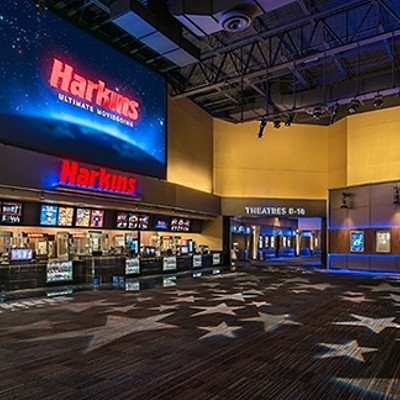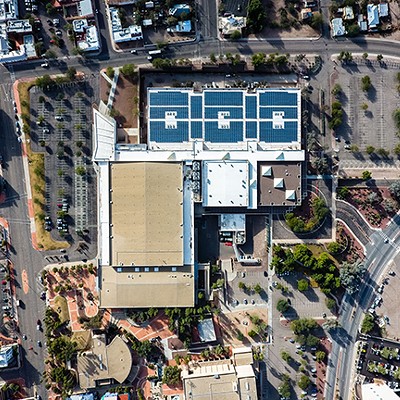Sixty acres of lush desert vegetation, including a few tall saguaro cacti, surround red-roofed, 2-year old Oyama Elementary School at the corner of 36th Street and La Cholla Boulevard. The Enchanted Hills Wash slices the vacant property in half, and winter rains have turned the ground lime-green.
East of the site, across the two-lane, misnamed boulevard, is a subdivision of modest brick houses built in the 1960s. To the west and north of the property sit mobile homes on one-acre lots, some of which also stable horses, continuing the rural character once dominant in the area, but which is now disappearing.
In December, residents were stunned by a proposal to develop the 60 acres of desert that is currently zoned for mobile homes on legally-mandated 36,000 square foot parcels. The concept plan for the new project showed 228 single-family lots averaging 5,000 square feet in size. Many were outraged by the idea and got together to defeat it.
When four local men who planned to buy the land met with about 25 members of the Enchanted Hills Neighborhood Association a few weeks ago, Rick Carson told the group he and his ExG Investments associates planned to purchase the property in two days.
Carson indicated they wanted to rezone the land to allow single-family construction, because "that's what the market requires." He added the development would have homes selling for around $180,000 and that the partners stood to gain about a $400,000 profit over three years if things went according to schedule.
Michael Grassinger, a land-use consultant with The Planning Center, emphasized that his clients were starting with a clean slate for the property and weren't in a hurry to make decisions. Stressing they wanted to hear the neighbor's opinions and concerns, Grassinger said: "We're not here to sell you anything, but to introduce ourselves and ask for your input."
At first, some in the audience were extremely hostile. In a belligerent tone, Scott Archer stated that 800 people were opposed the earlier rezoning proposal, and he believed they had the votes on the City Council to defeat another attempt to change the approved land use.
Even though Grassinger made it clear his clients hadn't decided on a total number of lots for their project, but that it would be less than 228, those attending the meeting remained unsupportive. "Who are you to invade us?" asked one, while another pointed out: "There is way too much traffic now. You can't even get in and out. It's not even safe to walk. People won't put up with it."
Summarizing the views of many of his neighbors, Richard Cahill told the developers: "These people don't want (your project). Why not go elsewhere?"
To that, Archer added: "I find your technical ignorance appalling. The land is hard rock that will require blasting. You're buying yourself a quarry. The costs (of development) will be way over your heads." Generously, Archer then said, "You're local men, and we don't want to see you lose money and stop work on the project."
After Carson's son, Travis, explained the investment group did testing on the site and were satisfied the project could work, several members of the audience chimed in with horror stories about rock in the area. In response, the developers asked to get together with them after the meeting.
Within a week, plans for the property were on hold. When contacted, Grassinger replied he was pretty sure his clients were going to drop their offer to buy the land because of the rocky conditions.
"As a result of the meeting," he said, "they did a follow-up on the soils. They want to meet again with the neighbors to thank them (for pointing this out)."
Before learning of this reversal, Enchanted Hills Neighborhood Association president Connie Harris stated she wanted to see the city of Tucson acquire the vacant property to preserve it, as is. After hearing of the developer's decision, she said, "They really did listen. Now we have to go to the next page."
That chapter in the saga of the 60 acres of desert land will contain a significant subplot. According to John Updike, head of Tucson's Real Estate Division, the city doesn't even have a program in place to acquire the vacant land.
"We don't have either the (financial) resources or land in our inventory to exchange to acquire the property," he said. "Pima County's Open Space Program is their best bet, but it has far more requests than funds available."
Westside City Council representative Jose Ibarra believes this situation must change. "We've got to have this tool to put in our arsenal," he says. "I'd like to see us work with the county to implement this program instead of doing things piecemeal."
For now, Harris is keeping her fingers crossed that the county will help. The neighborhood association has participated in on-going negotiations for government acquisition of a nearby desert parcel, and if those are successful, she hopes they will do the same for the 60-acre piece of land.
"The neighborhood will go back to work," Harris says, "and hold more meetings to discuss what to do. We don't want anything there, but somewhere along the line we'll have to make some concessions. If you look around, there's not much desert space available in Tucson. We'd like them to leave our little corner alone."












